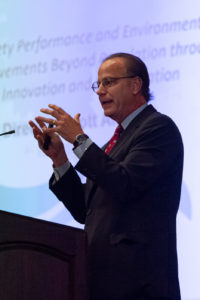Angelle: Every near-miss is important, should be reported
By Joshua Baethge, Contributor
The Director of the US Bureau of Safety and Environmental Enforcement (BSEE) Scott Angelle wants to take his agency beyond being an organization that writes regulations. He wants to ensure that regulations are appropriate and drive performance, and he wants to measure BSEE’s success by the performance of the regulated community, he said in a keynote address at the 2019 IADC Well Control Conference of the Americas in Galveston, Texas, on 27 August. “What I’m striving to do is make sure that offshore can be the biggest contributor to American energy security,” he said.
According to Director Angelle, the first major step toward having a more robust OCS was taken in December 2017, with the passage of the Tax Reform Act. That is already spurring investment and creating job growth. Now, his attention is focused on reducing regulatory burdens and improving safety.

BSEE has developed a six-point strategy of innovation and collaboration, the first of which is the SafeOCS near-miss reporting system. When Director Angelle was appointed to BSEE in 2017, the number of companies enrolled in this program represented only 4% of OCS oil production. That number has now reached 85% of production, but he sees more room for improvement.
“We need to get everybody because everybody’s near-miss has value to everybody else,” he said. “Even if you are the smallest operator out there, your near-miss is important.”
Another tool BSEE is using to drive safety and environmental stewardship is its risk-based inspection (RBI) program. Since its launch in March 2018, 125 offshore facilities have been subject to RBIs, leading to three safety alerts with 28 recommendations. “We believe that it’s driving performance,” he said.
Early this year, BSSE also began piloting the Accelerated Compliance Together program. The program allows for certain instances of non-compliance to become “work orders” if they are addressed in a timely manner. An initial analysis of the pilot program will be conducted in the coming January to measure its success.
Further, BSEE has set up a text messaging safety alert program, BSEE!Safe. It allows offshore workers to receive text messages directly on their personal cell phones with information on safety alerts and safety bulletins, thus bringing improved safety to the front lines. So far, approximately 2,000 offshore employees have signed up.
“We decided that in this world of text message and electronics, why wouldn’t we issue a safety alert direct to the front lines? That is the employee, because that’s whose behavior we are trying to change,” Director Angelle said.
Industry engagement and smarter regulations are the final points in BSEE’s strategy. Director Angelle noted that since assuming his role with BSEE, he has visited with many of the top producers on the OCS, such as Shell, BP and Chevron, as well as the many of the top drilling contractors, like Diamond Offshore, Transocean and Seadrill.
And he pointed to recent changes to the Well Control Rule as an example of a smarter regulation. “There’s a lot of conversation in America that we are rolling back. The Well Control Rule is an example of rolling forward,” he said, noting that the revised rule could result in up to $1.5 billion in savings for the offshore industry over the coming decade.
Out of a total 342 provisions in the rule, 68 provisions were revised and 33 were added. More importantly, every change was compared with the 424 recommendations from 26 reports and 14 organizations issued after Macondo. “We can look at the American people and say we did not ignore or contradict one of those recommendations,” he said.




